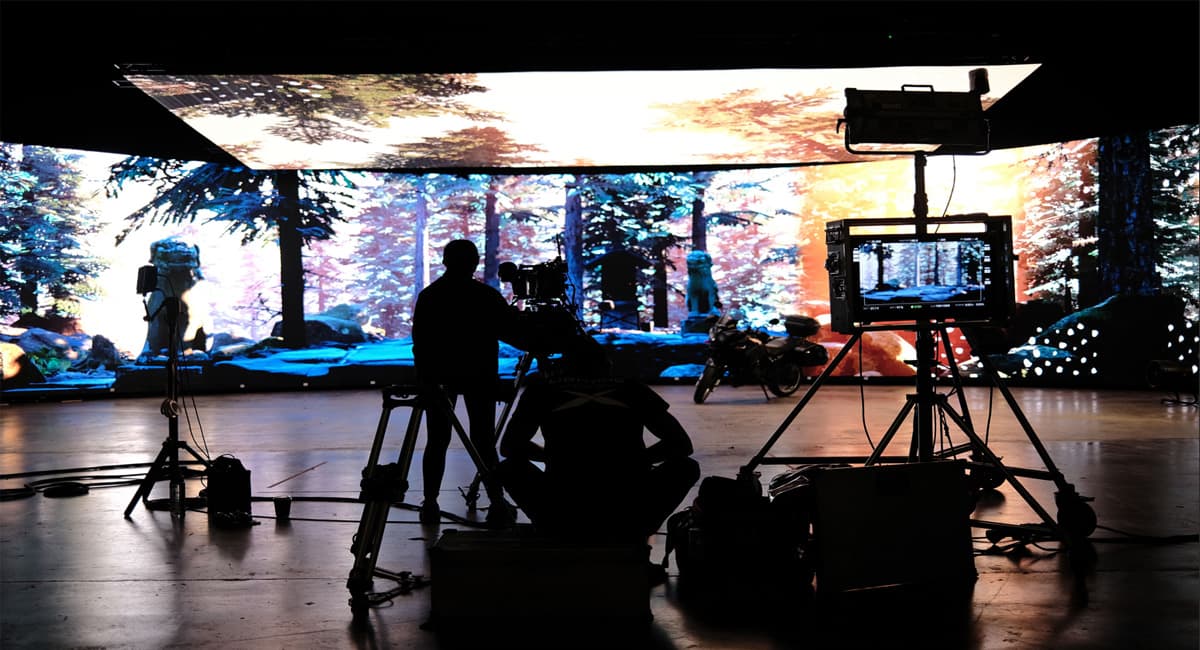Top 6 Skills of Virtual Background LED Screen Shooting
Virtual scene capture technology opens up amazing new possibilities for film and other video production. But it is a pity that many photographers do not know how to capture the shocking visual effects of virtual scenes. As with any new technology, there are a few tips and tricks to getting the best out of it.
Technically speaking, virtual background production covers a lot of content, but what people usually call virtual production refers to shooting the virtual scene of the LED display. Multiple cameras shoot the pictures on the LED display in real-time from multiple angles and use special software to synthesize and process the pictures.
The state-of-the-art setup doesn’t use filmed backgrounds at all, but instead uses a 3D virtual environment rendered in real-time by the game engine Unreal. A motion tracking system monitors the camera’s position within the volume and ensures that the correct viewing angle and parallax are displayed on the screen. In addition, the LED display screen needs to be bright enough to provide most or all of the lighting required for shooting in a very realistic way.
As a factory with many years of experience in LED display manufacturing, Galaxyav has successful cases in many LED display projects for virtual scene shooting. We often communicate with professional cinematographers to understand their shooting needs, and continuously improve the performance of our products to meet the needs of film production. Here are the top 6 virtual scene shooting tips that my photographer friends and I have summarized.

1. Shoot large format
To prevent the moiré effect from the LED pixels, the screen needs to be out of focus. This is easier to achieve by choosing an LF camera with a shallower depth of field. The Alexa Mini LF seems to be a popular choice, but the Sony VENICE (and possibly the VENICE 2) apparently works just as well.
2. Keep the distance between the camera and the LED display
In order to maintain the clarity and authenticity of the captured image, the camera should not be too close to the LED display. According to the experience of professional photographers, the distance between the camera and the screen should not be less than the distance between the pixels of the LED display. Note that the former unit of distance is meters, while the latter unit is millimeters. For example: the pixel pitch of the LED display is 2.5 mm, then the distance between the camera and the LED display should be kept more than 2.5 meters.
3. Use a diffusion filter
Professional virtual scene photographers find that the real foreground and virtual background come together more seamlessly if they use a mist or diffusion filter. Both the Mist and Diffuse filters soften the image, blending together light from elements near the frame. Other in-camera effects like rain (if the screen is rated weatherproof) and lens flare will also help. The virtual scene shot in this way will make the audience feel more real.
4. Use a panoramic LED screen
Many movies require multi-angle scene switching, which requires the LED display to present virtual content on more than one side. Moreover, the content of the LED display at all angles needs to be seamlessly connected, so it is particularly important to choose a high-quality flexible LED display. It is worth mentioning that when the ring or spherical LED flexible display is shooting, because of the self-illumination characteristics of the display, the light between the various image scenes is very well integrated, and the quality of the captured images is very satisfactory.
5. Light supplement when shooting
Because movies are generally shot in studios, it is impossible to 100% restore the real lighting conditions in nature, which requires supplementing part of the shooting brightness when shooting. Usually, we will choose a color temperature meter to measure the illumination data of the LED display, and then compare the actual lighting conditions, and use the pixel mapper to adjust each pixel on the LED display to supplement the difference. So as to achieve the effect of simulating the lighting conditions of the external natural environment.
6. Keep the camera moving steadily while shooting
Multiple cameras transmit data in real time to the central processing computer for real-time rendering when shooting. The higher the high-definition picture, the more powerful the computer data processing capability is, so it will cause the delay of the picture to a certain extent.
It is recommended to use a cart to move or use a shooting arm during shooting, which can maintain the stability of the camera and will not increase the delay time of rendering due to screen jitter. It is recommended to use a low frame rate when shooting, unless you have a very powerful processor for real-time rendering.
If you want to know more about our virtual scene LED display products or the success stories of our LED display in virtual shooting projects. You can fill in the relevant information in the form below, and our senior technical engineers will contact you as soon as possible and provide you with the information you need free of charge.
Others also read the following article
Want to know more about the Audio Visual Solutions?
